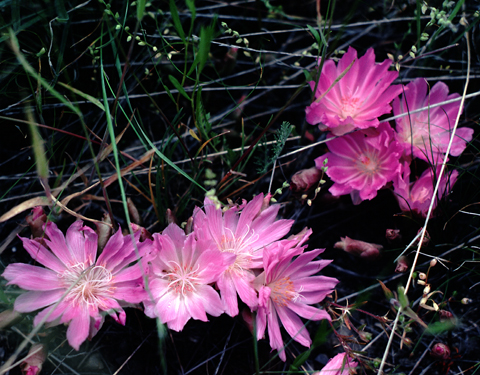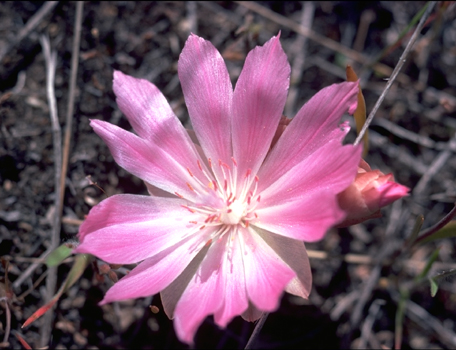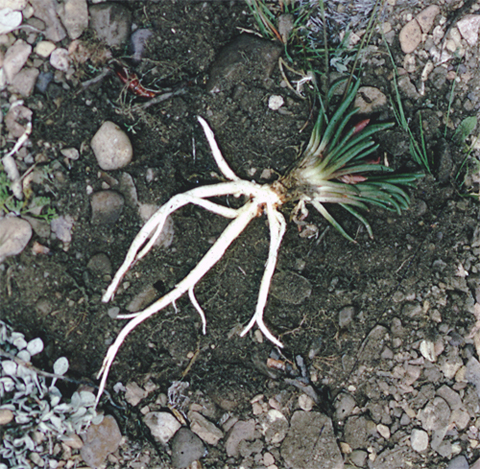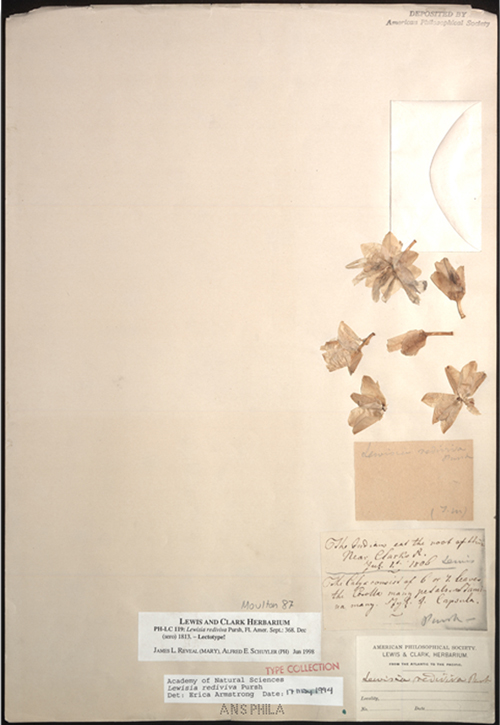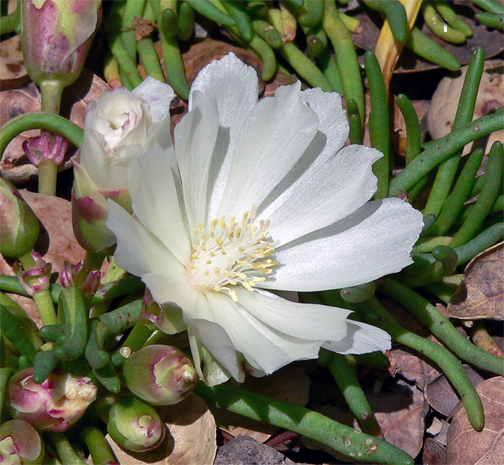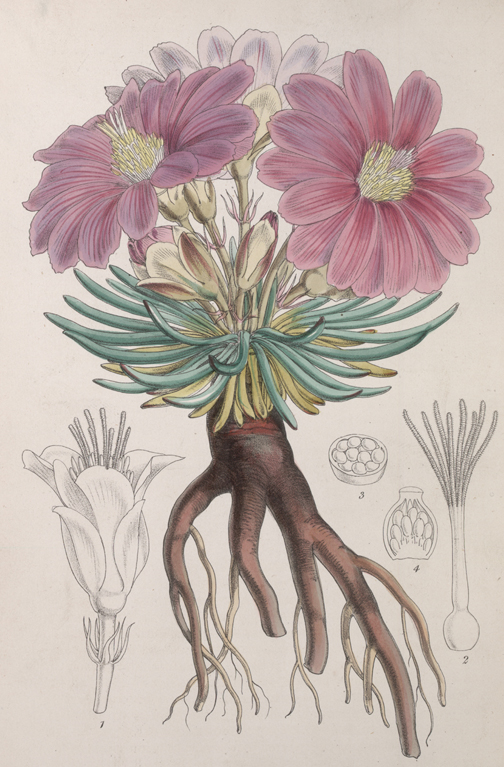Valley of the Racème Amer
By the middle of the 19th century, the entire valley of the river that Lewis had named in honor of his “worthy friend and fellow traveller Capt. Clark,” was widely known by the name that French-Canadian voyageurs and fur trappers had since given it—Racine amer. The French noun racine means “root” in English, and the adjective amer means “bitter.”[1]What has been passed along as the common français canadien name for the plant, often written as racème amer, and translated for English-speaking readers as “root [which is] … Continue reading
As a local place name in western Montana, “bitterroot” is a reminder that every springtime, for innumerable millennia, the whole 80-mile-long valley was a-bloom with the beautiful little herbaceous plant. Indeed, Clark noticed as he approached “Travelers Rest Creek” on 8 September 1805 that “The bottoms as also the hills Stoney bad land,” which made it prime bitterroot habitat, although he had no way of knowing that. Neither he nor his co-captain had yet seen one in bloom, nor had the leisure to observe the early-summer subsidence of one into its ten-month obscurity.
However, when the expedition returned to the mouth of Travelers’ Rest Creek early on 1 July 1806, Captain Lewis was in the nick of time to collect at least one complete specimen of the species. He couldn’t stay long enough to witness its apparent demise, so its annual life-and-death history could only have been related to him by Lemhi Shoshone or Salish informants. Back in Philadelphia in May 1807, on the recommendation of Bernard McMahon (ca 1775–1816), he turned his specimens over to one of the leading botanists of the day, Frederick Pursh (1774-1820), for official classification. In honor of Captain Lewis, Pursh established a new genus in the purslane or portulaca family, Latinizing it as Lewisia (lew-EE-see-uh; “of Lewis”), and designating this species rediviva (red-ih-VEE-vuh; “revived”).[2]Canadian Encyclopedia, s.v. Coureurs de bois; http://thecanadianencyclopedia.com Accessed 8 November 2014. J.M. Carrièrre, “Creole Dialect of Missouri,” American Speech, Vol. 14, No. 2 … Continue reading There are now 19 species in the genus Lewisia.
Life Cycles
The leaves of the bitterroot appear soon after the snow melts in the valleys, signaling that the roots are tender, nutritious, and ripe for harvesting. When the long, slender, conical buds take the places, between late April and the latter days of June—depending largely on the elevation—they draw starch from the roots, and the brownish-black bark becomes progressively more difficult to peel away.
Salish, Kutenai, Shoshoni, and Nez Perce people all regard the bitterroot with solemn reverence. No other root may be harvested until the elder women of the tribe have conducted the annual First Roots ceremony, just after leaves begin to appear on deciduous trees, and before the buds of other flowers and shrubs open for the first time. Sometime within that interval is the moment when the dark, extremely bitter skin of the plant’s roots can most easily be peeled away. In olden times each family quickly but methodically collected a bushel or two of roots—enough to last for a year—and spread them out to dry in the sun.
Uses
A Salish tribal elder peels spetlem (“bitter”), and tosses each root onto the drying pad before her. The bitterroot cannot be pulled from the ground; the gravelly soil must be carefully loosened until the whole plant can be lifted out. Beside the root bag is her long, sharp, two-handed iron digging tool. Prior to contact the tool was either made of a fire-hardened willow stick with part of a deer’s antler for a handle, or entirely of part of an elk’s antler.
Since the beginning of EuroAmerican settlement in the middle of the 19th century, more and more of the meadows and foothills in the valley of the Bitterroot River have been given over to agriculture, apple orchards, commerce, transportation and housing. One of the largest ancient beds near the confluence of the Bitterroot and Clark’s Fork Rivers is covered with suburban homes; another is now part of the campus of the University of Montana. Today the bitterroot is more likely to be found in a domestic rock garden somewhere else in the United States.
The root of the bitterroot was once considered highly nutritious, but in the late 1980s nutritional analysis showed it to contain only 3.87 calories per gram dry weight, 10 grams of protein, 0.85 grams of carbohydrate, and 2.35 mg of calcium, plus lesser amounts of lipid, ash, iron, magnesium and zinc.[3]H. H. Norton and others, “Vegetable food products of the foraging economies of the Pacific Northwest,” Ecology of Food and Nutrition, Vol. 14, No. 3 (1984), 224. It is somewhat starchy, though not as much so as, say, the root of the common dandelion. In any case, its particular starch is very hard for an unaccustomed stomach to digest, which may account for the fact that even Indians ate only small portions of the root, usually mixed with other ingredients—as a thickener in soup, for instance. When cooked by itself it swells up into an unappetizing, gelatinous pink glop. At best, as some wild-food epicures will cheerfully attest, it’s an acquired taste. But you won’t find it in a health-food store.
Historically the bitterroot has seen service as a medicine—to increase the flow of milk in nursing mothers; to relieve the pain of a sore throat; to neutralize poison ivy rash; or to suppress symptoms of diabetes. Generally, though, it has only its acerbic flavor to recommend it as a medicament. Anything that tastes that bad must be very good for you.
Thus, it may be that the unusual life cycle of the bitterroot is what has made it spontaneously appealing. It beautifully symbolizes the mysteries of birth, death and resurrection—that irrepressible, universal human longing for immortality.
First Named Spetlem
An old Salish Indian woman sat weeping on the bank of the In-schu-te-schu, or Red Willow River, in the shadow of the Chi-quil-quil-kane, or Red Mountains, singing a death song for her starving children. The rising sun heard her plaint, and sent a red spirit-bird to comfort her. The bird promised that from each of her falling tears a new flower would grow, tinted with the rose of his feathers and the white of her hair, and springing from a root as bitter as her sorrow but as nourishing as her love. The prophecy came true, and her people called the plant spetlem—”bitter.”
As soon as the grass begins to turn green in April, this plant puts forth its small, cylindrical, tapered, deep-green leaves from a short stalk that is barely visible at the surface of the ground. Late in the fifth lunar month of the year, from five to ten two-inch flowerstalks reach up with buds that the morning sun unfolds, and the evening twilight closes to rest. In due time the leaves begin to shrivel and die, and the plant puts all its energy into creating its flowers.
Each blossom is unique, for so is each petal. Day by sun-started day the color fades, until the petals dry up and blow away, leaving a tiny parasol-shaped capsule of jet-black seeds, soon to be sown near and far by the wind. By early July—too soon, too soon—all visible traces of the plant will have disappeared like tears into the gravelly soil, awaiting another distant spring for its rebirth. Even if the root is pulled up, dried, and kept for months, it can be replanted, and it will be born again. Rediviva!
Bitterroot Namesakes
The plant commonly called bitterroot is found throughout the Rocky Mountains from British Columbia and Alberta south to California and Colorado, but it is especially abundant in western Montana. By 1889 the valley and its river, bordered by the eastern slopes of a great mountain range, had all three gotten their names from the bitterroot plant. In 1889, they became a part of Montana, the forty-first state in the union.
Out of the scientific floral exhibit displayed at the Columbian Exposition of 1893, in Chicago, Illinois, grew the National Floral Emblem Society of America. State chapters of the society conducted informal balloting, and referred the winners to their respective legislatures for endorsement. In Montana the bitterroot handily won over thirty-one other contenders, and was officially designated the state flower in 1895.
Lewis’s Specimen
The “T.M.” in parentheses stands for Thomas Meehan (1826-1901), a botanist at the Academy of Natural Sciences who, in the late 1890s, found many of Lewis’s specimens at the American Philosophical Society, where they had lain untouched and forgotten for three-quarters of a century. He moved them to the Academy’s collection, mounted them, and in 1898 published the first list of the Lewis and Clark Herbarium. He attests by his initials that it is he who has labeled these few remains of Lewis’s specimen–parts of a flower or two–which Frederick Traugott Pursh (1774–1820) had named Lewisia rediviva. Pursh was the young German botanist and former curator for the Philadelphia naturalist Benjamin Smith Barton. In 1807 Lewis entrusted his entire collection to Pursh for organization, classification, and entry into the corpus of contemporary botanical literature.
The phrase “Near Clark’s R. Jul. 1st 1806 Lewis”–written by Frederick Pursh–relates that Lewis collected the specimen on 1 July 1806 in the vicinity of Travelers’ Rest near the river that Lewis had named for his “worthy friend and fellow traveller Capt. Clark,” but is now called the Bitterroot River. Gary Moulton believes that Lewis’s journal entry for July second suggests that he might have collected it on that day instead: “I found several other uncommon plants specemines of which I preserved.” But that’s of minor importance.
The next sentence, also in the handwriting of Frederick Pursh, states first that the calyx, or group of sepals, consists of sometimes six, sometimes seven leaves. In the photograph the sepals are the pale leaves behind the pink petals. The corolla consists of “many pedals” (i.e., petals) and many “Tamina” (stamens). The stamens in the center, surrounded by the pink petals, are the male organs of the flower; they are topped by what Pursh called “Capsula,” but now are called anthers. Meehan may have added Pursh’s name to this label. The white envelope at upper right is the “packet” that contained pieces of the plant that have dropped off of the specimen at some time.
Pursh’s Analysis
Why is there no root, stem, sepal or leaf accompanying the bedraggled petals? Pursh answered that question in his comment on the plant in his book, Flora Americae Septentrionalis (1814):
This elegant plant would be a very desirable addition to the ornamental perennials, since, if once introduced, it would be easily kept and propagated, as the following circumstance will clearly prove. The specimen with roots taken out of the Herbarium of M. Lewis, Esq. was planted by Mr. M’Mahon of Philadelphia, and vegetated for more than one year: but some accident happening to it, I had not the pleasure of seeing it in flower.[4]Flora Americae septentrionalis, 2 vols. (London: White, Cochrane, and Co., 1814), No. 437, 2:368.
Pursh’s reference was to the Irish-American horticulturist Bernard McMahon (1775-1816), who emigrated to America in 1796.[5]McMahon’s principal achievement as a botanist was his initial authorship of The American Gardener’s Calendar: Adapted to the Climates and Seasons of the United States, which was published … Continue reading In 1806, Thomas Jefferson named Pursh as one of two nurserymen to grow the seeds and roots brought back by Lewis and Clark, and it was McMahon who recommended him as the illustrator for Lewis’s proposed book of botanical discoveries. It is thought that the “accident” he referred to was actually the well-meaning McMahon’s excess of care and attention, which led him to over-water the dormant root, unaware that it belonged to a dryland species which still held enough moisture to enable its rejuvenation. Evidently McMahon discarded the remains.
Whatever the cause, McMahon evidently discarded the remains, so the alien species Lewisia rediviva had to hold its secrets for another half-century before its image could seduce curious eyes. Meanwhile, the only alternative was Pursh’s dispassionate “diagnosis,” a 72-word paragraph consisting of terse answers to ten key questions that its author might have discussed in a conversation with Lewis himself. However, it would have been of no use to anyone but another well educated botanist, because it was written in botanical Latin.[6]As a botanical term, a diagnosis is a paragraph of aphoristic statements in the ablative case which describe the most distinguishing features of a plant, expressed in a blend of classical Latin with … Continue reading Years passed–49 of them to be exact–while the small envelope containing the pitiful remains of the plant Pursh had named for him languished in the herbarium at the Royal Gardens of Kew, in a suburb of London, where Pursh had left them.
First Picture
Notes
| ↑1 | What has been passed along as the common français canadien name for the plant, often written as racème amer, and translated for English-speaking readers as “root [which is] bitter,” is problematic. Racème is not a French word in the standard European French dialect, so its translation as “root” was incorrect. On the other hand, without the grave accent over the first /e/, raceme is a bona fide Latin botanical term denoting an inflorescence which is “elongated axillary, or terminal many-flowered”—such as the inflorescence of the beargrass—and obviously was not applicable to the bitterroot’s singular flowers. The confusion may have originated with some anonymous representative of the independent, entrepreneurial class of Canadian fur traders known as coureurs des bois—”runners of the woods”—who collectively were the captains of their profession throughout the French Regime, which lasted from 1535 until the British acquired the French territory in 1763. Individually those young Frenchmen often lived with, and took wives/partners from, one or more native tribes in succession, making their language and lifeways his own. Thus it is possible that racème simply crept into intercultural conversations in place of racine during the flower’s brief season. The same transformation might have occurred within the small, isolated community of simple and illiterate French Canadians—Creoles, they called themselves—traders, trappers and voyageurs who settled in the foothills of the Ozarks late in the 17th century, and plied their trades along the Missouri River until the middle of the 19th. In comparison with other French dialects in North America, such as the Acadian and Louisianan, their phonology was unique by virtue of their geographical isolation from any other French-speaking people for almost 150 years. Or, the confusion over the French name for bitterroot may have been the much quicker consequence of an unnamed, inquisitive English-speaking traveler who aurally mistook racine for raceme and was unaware of the difference, but wrote it in a memoir or a letter, whence it took on a durable authenticity. |
|---|---|
| ↑2 | Canadian Encyclopedia, s.v. Coureurs de bois; http://thecanadianencyclopedia.com Accessed 8 November 2014. J.M. Carrièrre, “Creole Dialect of Missouri,” American Speech, Vol. 14, No. 2 (April 1939), 110–13. |
| ↑3 | H. H. Norton and others, “Vegetable food products of the foraging economies of the Pacific Northwest,” Ecology of Food and Nutrition, Vol. 14, No. 3 (1984), 224. |
| ↑4 | Flora Americae septentrionalis, 2 vols. (London: White, Cochrane, and Co., 1814), No. 437, 2:368. |
| ↑5 | McMahon’s principal achievement as a botanist was his initial authorship of The American Gardener’s Calendar: Adapted to the Climates and Seasons of the United States, which was published annually from 1806 until 1857. Allen Lacy, “Bernard McMahon’s Declaration of Independence,” in Farther Afield: A Gardener’s Excursions (New York: Macmillan, 1986). |
| ↑6 | As a botanical term, a diagnosis is a paragraph of aphoristic statements in the ablative case which describe the most distinguishing features of a plant, expressed in a blend of classical Latin with latinized words from Greek, English and many other languages, now collectively known as “botanical Latin.” About 80 per cent of all generic names (such as Lewisia) and 30 per cent of specific epithets are from languages other than Latin and Greek. As the worldwide lingua franca of botanical science, its lexicon and grammatical rules are strictly governed and enforced by the ICN, or International Code of Nomenclature for algae, fungi, and plants, founded in 1905 after a long and tortuous search for clarity and simplicity. For example, with the publication of his Systema Naturae in 1735, Carl Linnaeus had chosen to limit his diagnoses to a maximum of 12 words in the interest of brevity and convenience, but by 1814–coincidentally the year of publication of Nicholas Biddle‘s paraphrase of the journals of Lewis and Clark–the science of botany had gained so much momentum that the 80-year-old limitation was a burden on the science, which accounts for Pursh’s 72-word descriptive document. In 2011, at the 18th International Botanical Congress, the historic requirement that the validating diagnosis must be in Latin was changed to allow new names to be validated with diagnoses in English. William T. Stearn, Botanical Latin: History, Grammar, Syntax, Terminology and Vocabulary, 4th ed. (Trowbridge, England: David & Charles Publishers, 1993), passim. |
Experience the Lewis and Clark Trail
The Lewis and Clark Trail Experience—our sister site at lewisandclark.travel—connects the world to people and places on the Lewis and Clark Trail.
Discover More
- The Lewis and Clark Expedition: Day by Day by Gary E. Moulton (University of Nebraska Press, 2018). The story in prose, 14 May 1804–23 September 1806.
- The Lewis and Clark Journals: An American Epic of Discovery (abridged) by Gary E. Moulton (University of Nebraska Press, 2003). Selected journal excerpts, 14 May 1804–23 September 1806.
- The Lewis and Clark Journals. by Gary E. Moulton (University of Nebraska Press, 1983–2001). The complete story in 13 volumes.
